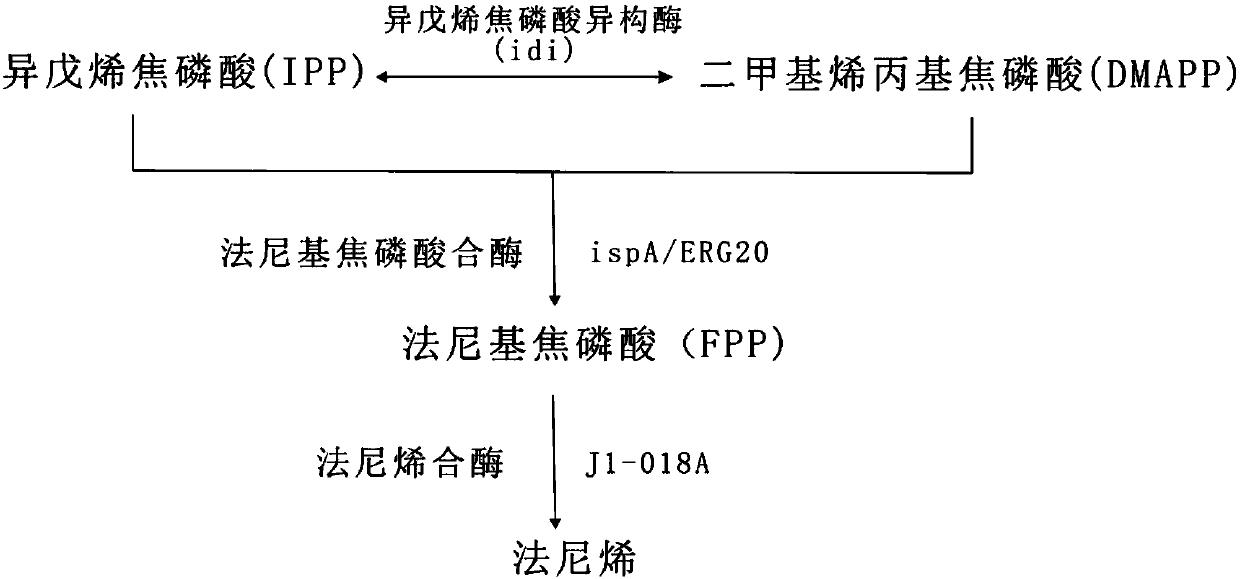Microorganism and application thereof
A microorganism and microbial fermentation technology, applied in the field of bioengineering, can solve the problems of chemical reagent residues, low farnesene content, and inability to use, and achieve the effects of short production cycle, overcoming genetic manipulation difficulties, and improving yield and efficiency.
- Summary
- Abstract
- Description
- Claims
- Application Information
AI Technical Summary
Problems solved by technology
Method used
Image
Examples
Embodiment 1
[0022] Example 1 Reconstruction of the MEP pathway in vitro
[0023] The in vitro reconstitution method was the same as that established by Zhu et al. in 2014 (Zhu F, et al., 2014. In vitroreconstitution of mevalonate pathway and targeted engineering of farnesene overproduction in Escherichia coli. Biotechnol Bioeng. 111(7): 1396-405.). The inventors have found through further in-depth research on each protein in the MEP pathway that increasing the protein content of dxr and ispG can inhibit the increase of farnesene, while increasing the content of idi protein can promote the increase of farnesene, see image 3 . Finally, it was found that the optimal ratio of each protein in the MEP pathway obtained from the in vitro reconstruction experiment was dxs:dxr:ispD:ispE:ispF:ispG:ispH:idi:J1-018-A=2:1:2:2:2:1: 2:5:5, compared with the equimolar amount of each protein, the reaction rate is significantly improved, refer to Figure 4 .
Embodiment 2
[0024] Construction of MEP pathway optimization ratio protein expression plasmid in embodiment 2 Escherichia coli
[0025] The optimal ratio of each protein for producing farnesene by the above-mentioned in vitro approach is dxs:dxr:ispD:ispE:ispF:ispG:ispH:idi:J1-018-A=2:1:2:2 :2:1:2:5:5, so the inventor followed the guidance of this method to construct related expression plasmids. The construction method is as follows:
[0026]Plasmid pJ1-018-1 plasmid contains dxs, ispD, ispE, ispF, ispH derived from the MEP pathway, these genes are obtained by PCR, and the genes encode proteins in Escherichia coli BL21 with the number CP001509.3 in the genebank library The sequences are ACT42267.1, ACT44416.1, ACT43075.1, ACT44415.1, and ACT41935.1, and these gene fragments are linked in turn by designing primers, and a 50bp overlapping sequence is formed between two adjacent genes, using the Gisbson method (Gibson.D.G., 2011.Enzymatic assembly of overlapping DNA fragments.MethodsEnzymol....
Embodiment 3
[0031] The construction of embodiment 3 farnesene producing bacteria
[0032] The plasmid pJ1-018-3 was directly transformed into Escherichia coli BL21(DE3), and the obtained strain was named strain J1-018-2.
[0033] The plasmids pJ1-018-1, pJ1-018-2 and pJ1-018-3 were transformed into Escherichia coli BL21(DE3), and the obtained strain was named strain J1-018-3.
[0034] According to the fermentation method in the literature (Zhu F, et al., 2014.In vitro reconstitution of mevalonate pathway and targeted engineering of farnesene overproduction in Escherichia coli.Biotechnol Bioeng.111(7):1396-405.), the strain was carried out to shake flask fermentation, The results show that the production of farnesene can be detected in the strain J1-018-2, but the production is only 30mg / L, but the production of J1-018-3 is significantly increased, and the production of farnesene 48 hours after induction is 1.6g / L, the follow-up continued to increase.
[0035] in conclusion:
[0036] 1...
PUM
 Login to View More
Login to View More Abstract
Description
Claims
Application Information
 Login to View More
Login to View More - R&D Engineer
- R&D Manager
- IP Professional
- Industry Leading Data Capabilities
- Powerful AI technology
- Patent DNA Extraction
Browse by: Latest US Patents, China's latest patents, Technical Efficacy Thesaurus, Application Domain, Technology Topic, Popular Technical Reports.
© 2024 PatSnap. All rights reserved.Legal|Privacy policy|Modern Slavery Act Transparency Statement|Sitemap|About US| Contact US: help@patsnap.com










